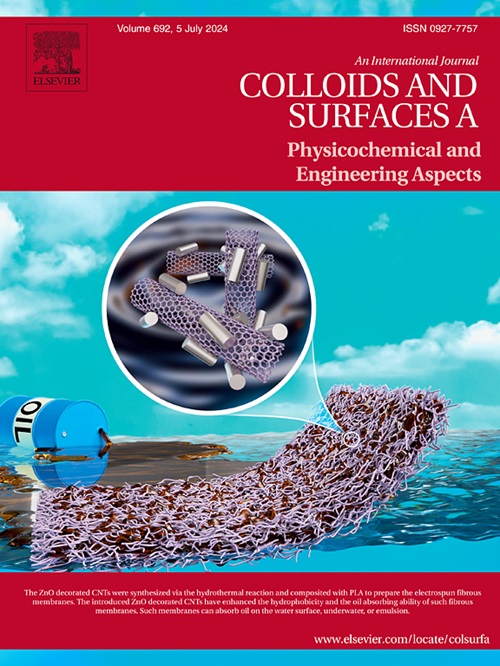Effect of anodic treatment on the electrocatalytic activity of electrodeposited Ni-Mo coatings as cathode materials for hydrogen evolution reaction
IF 4.9
2区 化学
Q2 CHEMISTRY, PHYSICAL
Colloids and Surfaces A: Physicochemical and Engineering Aspects
Pub Date : 2024-10-29
DOI:10.1016/j.colsurfa.2024.135677
引用次数: 0
Abstract
The influence of anodic treatment of electrodeposited Ni-Mo coatings with different chemical composition, obtained from a self-regulating electrolyte, on the evolution of their morphology and change in roughness parameters was studied. At the same time, the kinetic characteristics of anodic polarization are taken into account, which determine the electrocatalytic activity of the coatings in the hydrogen evolution reaction (HER). The hydrogen evolution reaction on anodized coatings follows the combined Volmer-Heyrovsky mechanism, with the rate determined by the adsorption of hydrogen ions on the coating surface, which correlates with the molybdenum content. The enhanced catalytic properties of the coatings after anodic treatment are attributed to the selective dissolution of nickel, which increases the specific surface area and contributes to the formation of active centers for the electrochemical desorption of hydrogen (molybdenum oxides). The chemical composition and surface morphology of the coatings were investigated using SEM and EDX analyses, while their roughness was assessed by profilometry. Kinetic parameters and the HER mechanism were determined through linear voltammetry and Tafel analysis. The relationships between the kinetic parameters of anodic potentiostatic treatment of Ni-Mo coatings with different compositions in 0.5 M HCl and their surface morphology and roughness coefficients can be used to predict the electrocatalytic activity of materials employed in the electrolytic synthesis of green hydrogen.
阳极处理对作为氢进化反应阴极材料的电沉积镍钼涂层电催化活性的影响
研究了在自调节电解液中获得的不同化学成分的电沉积镍钼涂层的阳极处理对其形态演变和粗糙度参数变化的影响。同时,还考虑了阳极极化的动力学特征,这些特征决定了涂层在氢进化反应(HER)中的电催化活性。阳极氧化涂层上的氢演化反应遵循 Volmer-Heyrovsky 组合机理,其速率由涂层表面的氢离子吸附决定,与钼含量相关。阳极处理后涂层的催化性能增强,这是因为镍的选择性溶解增加了比表面积,有助于形成电化学解吸氢(钼氧化物)的活性中心。利用 SEM 和 EDX 分析法研究了涂层的化学成分和表面形态,同时利用轮廓仪评估了涂层的粗糙度。通过线性伏安法和 Tafel 分析确定了动力学参数和 HER 机制。在 0.5 M HCl 中对不同成分的镍钼涂层进行阳极电位静电处理的动力学参数与其表面形貌和粗糙度系数之间的关系可用于预测电解合成绿色氢气所用材料的电催化活性。
本文章由计算机程序翻译,如有差异,请以英文原文为准。
求助全文
约1分钟内获得全文
求助全文
来源期刊
CiteScore
8.70
自引率
9.60%
发文量
2421
审稿时长
56 days
期刊介绍:
Colloids and Surfaces A: Physicochemical and Engineering Aspects is an international journal devoted to the science underlying applications of colloids and interfacial phenomena.
The journal aims at publishing high quality research papers featuring new materials or new insights into the role of colloid and interface science in (for example) food, energy, minerals processing, pharmaceuticals or the environment.

 求助内容:
求助内容: 应助结果提醒方式:
应助结果提醒方式:


